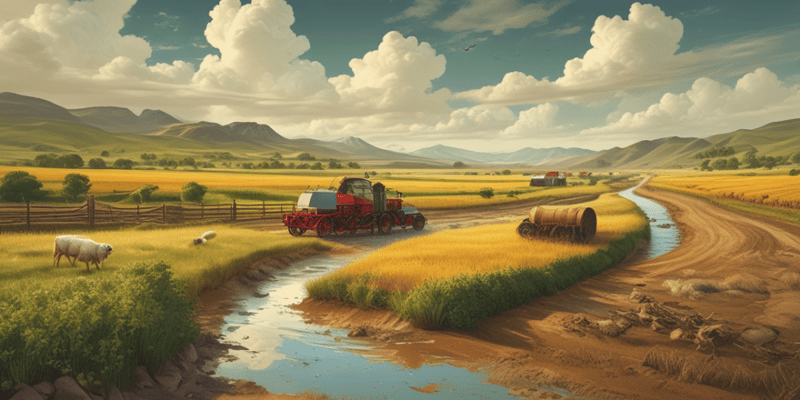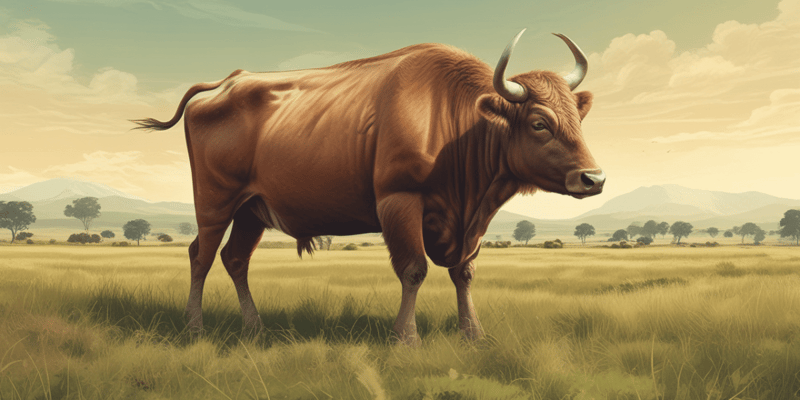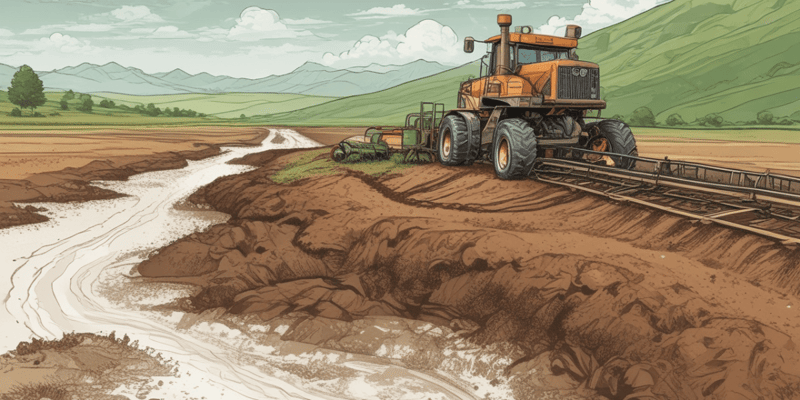Podcast
Questions and Answers
What is the primary reason for the loss of fertility in soil when land is cleared of its natural vegetation?
What is the primary reason for the loss of fertility in soil when land is cleared of its natural vegetation?
What is the term for the removal of soil by concentrated water running through little streamlets?
What is the term for the removal of soil by concentrated water running through little streamlets?
What is the consequence of intense plowing and drought on soil?
What is the consequence of intense plowing and drought on soil?
What is the result of the more altered the soil, due to plowing and agriculture?
What is the result of the more altered the soil, due to plowing and agriculture?
Signup and view all the answers
What is the name of the event in the 1930s that highlighted the issue of soil erosion in the US?
What is the name of the event in the 1930s that highlighted the issue of soil erosion in the US?
Signup and view all the answers
What is the primary difference between soils of an unplowed forest and soils of previously forested land that has been plowed and used for agriculture?
What is the primary difference between soils of an unplowed forest and soils of previously forested land that has been plowed and used for agriculture?
Signup and view all the answers
What was the primary purpose of using organic fertilizers in traditional agriculture?
What was the primary purpose of using organic fertilizers in traditional agriculture?
Signup and view all the answers
What is the estimated time it takes for 1 mm of soil formation?
What is the estimated time it takes for 1 mm of soil formation?
Signup and view all the answers
What is the result of sedimentation in waterways?
What is the result of sedimentation in waterways?
Signup and view all the answers
What is the estimated amount of topsoil lost in the US since WWII?
What is the estimated amount of topsoil lost in the US since WWII?
Signup and view all the answers
What is the primary source of phosphorous in agriculture?
What is the primary source of phosphorous in agriculture?
Signup and view all the answers
What is the goal of sustainable soil management?
What is the goal of sustainable soil management?
Signup and view all the answers
What is the primary benefit of contour plowing on sloping ground?
What is the primary benefit of contour plowing on sloping ground?
Signup and view all the answers
What percentage of the Earth's land area is used as rangeland?
What percentage of the Earth's land area is used as rangeland?
Signup and view all the answers
What is the result of exceeding the carrying capacity of grazing lands?
What is the result of exceeding the carrying capacity of grazing lands?
Signup and view all the answers
What is the primary factor that determines whether an area becomes a desert or not?
What is the primary factor that determines whether an area becomes a desert or not?
Signup and view all the answers
What is the definition of desertification?
What is the definition of desertification?
Signup and view all the answers
What percentage of the Earth's land area should be desert based on climate alone?
What percentage of the Earth's land area should be desert based on climate alone?
Signup and view all the answers
What is a consequence of overgrazing on rangelands?
What is a consequence of overgrazing on rangelands?
Signup and view all the answers
What is the leading cause of desertification worldwide?
What is the leading cause of desertification worldwide?
Signup and view all the answers
What is the first step in preventing desertification?
What is the first step in preventing desertification?
Signup and view all the answers
What is the primary cause of damage to streams and rivers in rangelands?
What is the primary cause of damage to streams and rivers in rangelands?
Signup and view all the answers
What is one of the effects of desertification on soil?
What is one of the effects of desertification on soil?
Signup and view all the answers
What is a good soil conservation method mentioned in the text?
What is a good soil conservation method mentioned in the text?
Signup and view all the answers
Study Notes
Sustaining Soil
- Contour plowing: a method to reduce soil erosion, uses less fuel and time, and minimizes erosion on sloping ground by plowing perpendicular to the slopes.
Grazing on Rangelands
- Almost half of the Earth's land area is used as rangeland, with 30% being arid rangeland that's easily damaged, especially during drought.
- Streams and rivers can be damaged by trampling and fecal matter from grazing.
- Carrying capacity is the maximum number of species per unit area that can persist without decreasing the ability of that population or its ecosystem to maintain that density in the future.
- Exceeding carrying capacity leads to overgrazing, which slows vegetation growth, reduces plant diversity, and increases soil erosion.
Desertification
- Desertification is the deterioration of land in arid, semiarid, and dry sub-humid areas due to changes in climate and human activities, affecting 1/6 of the world's population (1 billion people).
- Deserts occur naturally where there is too little water for substantial plant growth.
Farming and the Environment
- Agriculture is a major source of environmental damage, with problems including soil erosion, sediment transport, on-site and off-site pollution, deforestation, and loss of biodiversity.
Soil and Soil Profile
- Plowing can either be beneficial or detrimental to soil, depending on the method and frequency.
- The more soil is altered, the more material must be added each year, such as fertilizers and pesticides.
- Soil fertility is lost when natural vegetation is cleared, making it susceptible to erosion.
Soil Erosion
- Soil erosion is a major environmental problem, with intense plowing and drought causing massive soil loss, such as during the 1930s Dust Bowl in the US.
- Rill erosion is the removal of soil by concentrated water running through little streamlets, exacerbated by tillage (plowing).
Preventing Desertification
- The leading cause of desertification is bad farming practices, such as failure to use contour plowing, overfarming, overgrazing, and poor forestry practices.
- Prevention methods include detection of symptoms, soil conservation, forest management, and proper irrigation techniques.
Soil Conservation
- Good soil conservation practices include the use of wind breaks, reforestation, and proper irrigation methods.
- Preventing soil erosion involves maintaining soil fertility through organic and chemical fertilizers, as well as minimizing the damage caused by mechanized farming.
Soil Formation and Erosion
- Soil forms continuously, but very slowly, with 1 mm of soil formation taking 10-40 years.
- To be truly sustainable, soil lost should equal the amount of new soil produced.
- Eroded soil can travel through streams and rivers, causing sedimentation, chemical effects, and damage to fisheries and coral reefs.
Studying That Suits You
Use AI to generate personalized quizzes and flashcards to suit your learning preferences.
Related Documents
Description
Test your knowledge on the environmental impact of agriculture, including soil erosion, pollution, and deforestation. Learn how farming practices affect the environment and ecosystems.




